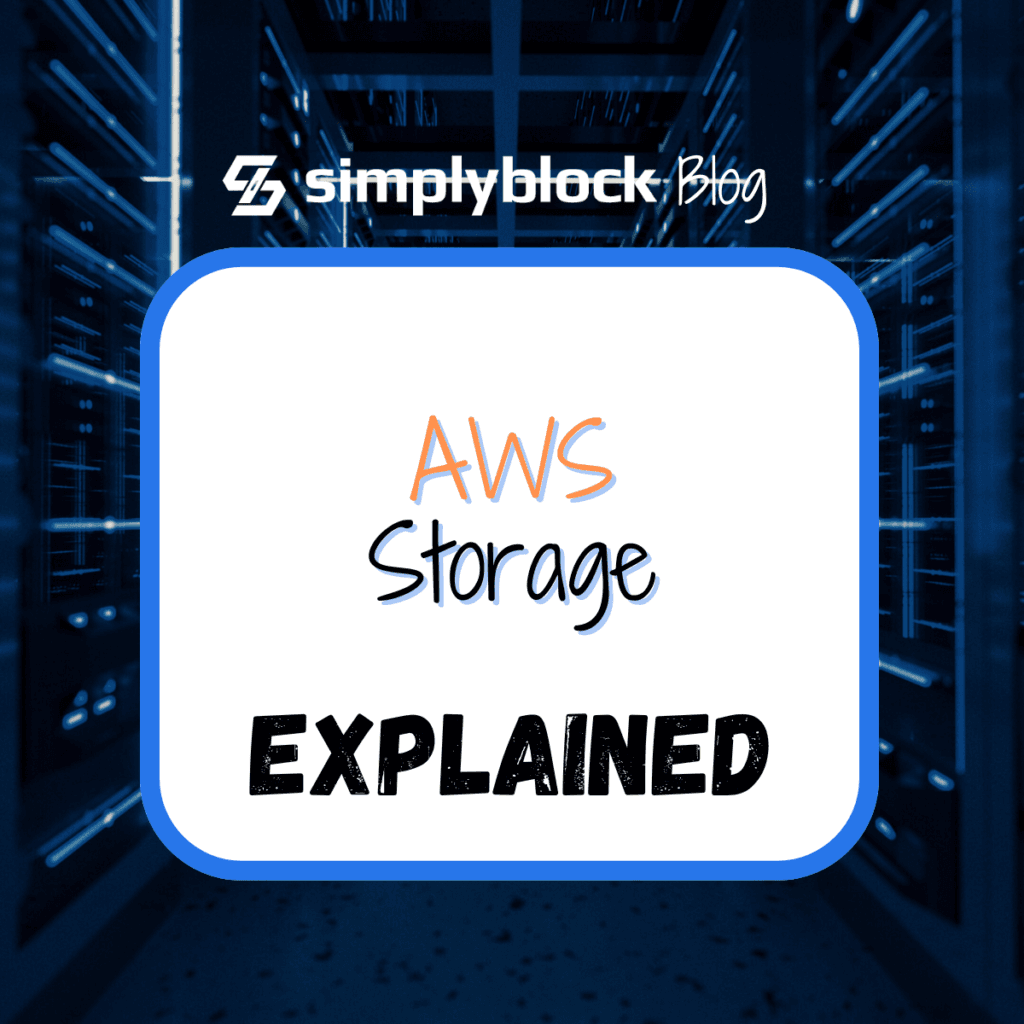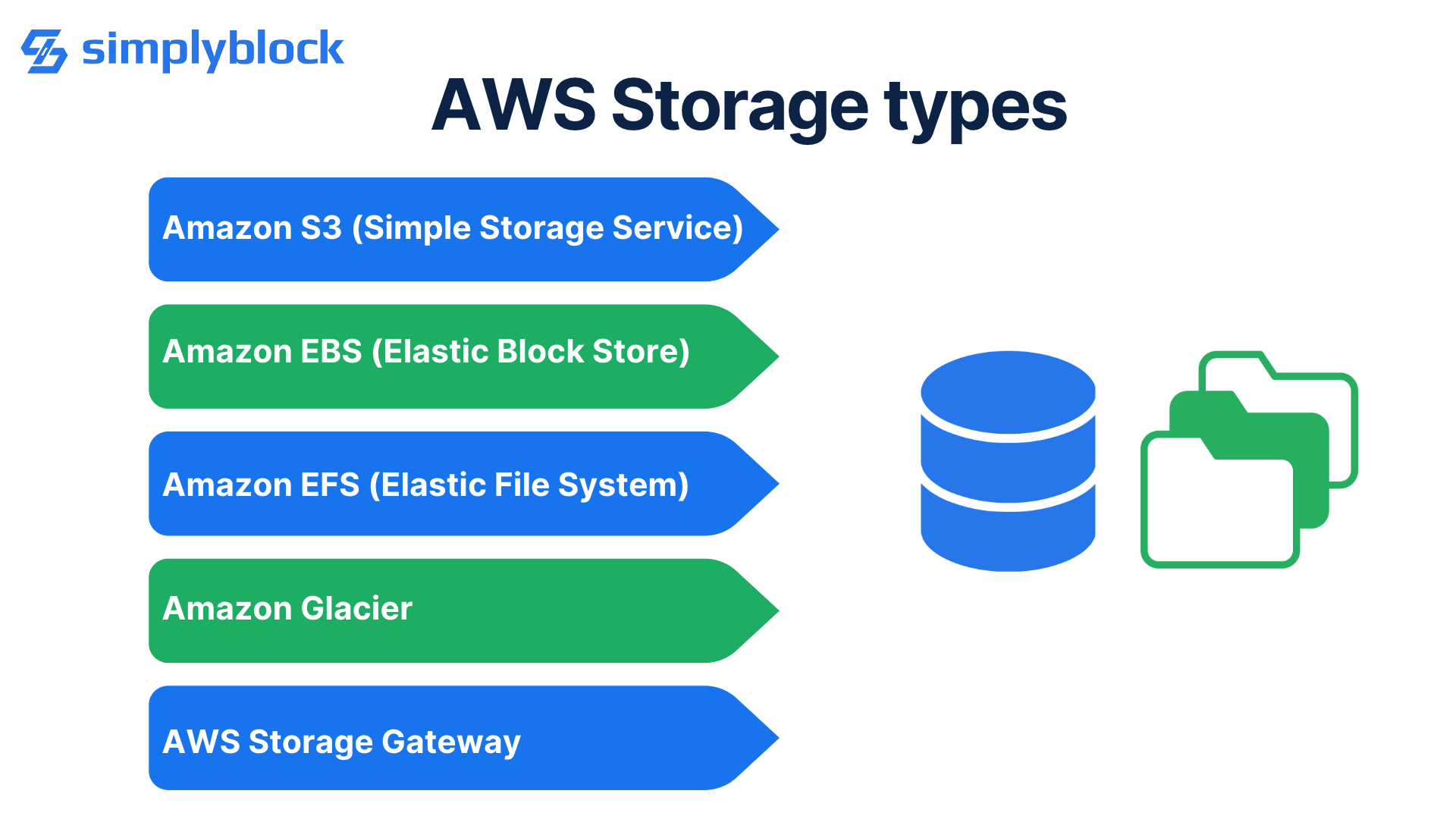
Introduction to AWS Storage
What is AWS Storage?
AWS Storage refers to the various cloud storage solutions provided by Amazon Web Services (AWS). Core AWS Storage services are S3, EBS and EFS. These services enable users to store, manage, and retrieve data over the internet, offering scalable and secure storage options tailored to different needs. AWS Storage solutions are integral for businesses and developers who require reliable, high-performance storage that can grow with their demands.
Why is AWS Storage Important?
AWS Storage services are crucial for managing vast amounts of data efficiently. It provides flexibility, scalability, and cost-effectiveness, making it suitable for a wide range of applications—from simple data backup to complex data analytics and high-performance computing. Understanding AWS Storage types and costs helps businesses optimize their data management strategies and budgets.
AWS Storage offers scalable, secure, and cost-effective solutions for all your data management needs.
Types of AWS Storage
Amazon S3 (Simple Storage Service)
- Features: Amazon S3 is an object storage service designed for storing and retrieving any amount of data at any time. It offers high durability, availability, and scalability. Key features include data redundancy, versioning, and a user-friendly web interface.
- Use Cases: S3 is ideal for backup and restore, archiving, data lakes, content distribution, and big data analytics. Its versatility makes it a go-to choice for many organizations needing reliable storage solutions.
- Pricing: Amazon S3 pricing is based on the amount of data stored per month, data retrieval requests, and data transfer out of S3. Pricing is tiered, so costs decrease as you store more data. 2. Amazon EBS (Elastic Block Store)
- Features: Amazon EBS provides block storage for use with Amazon EC2 instances. It offers high-performance storage that can be attached to EC2 instances for running applications. Features include snapshot capabilities, data encryption, and performance optimization.
- Use Cases: EBS is used for applications requiring a database, file system, or access to raw block storage. It’s suitable for workloads such as databases, enterprise applications, and transactional data.
- Pricing: EBS pricing is based on the type and size of the volume, the amount of I/O operations, and data transfer. Different volume types, such as General Purpose SSD and Provisioned IOPS SSD, have varying cost structures. 3. Amazon EFS (Elastic File System)
- Features: Amazon EFS provides scalable file storage that can be shared across multiple EC2 instances. It offers automatic scaling, high availability, and consistent performance. EFS supports NFS (Network File System) protocols.
- Use Cases: EFS is ideal for applications that require shared access to files, such as content management systems, web serving, and big data analytics.
- Pricing: EFS pricing includes costs for the amount of data stored per month and data transfer. It offers two storage classes: Standard and Infrequent Access, with different pricing models based on access frequency. 4. Amazon Glacier
- Features: Amazon Glacier is a low-cost storage service designed for long-term data archiving and backup. It provides secure and durable storage at a fraction of the cost of S3, with retrieval times ranging from minutes to hours.
- Use Cases: Glacier is used for archival storage, long-term backups, and data that is infrequently accessed but must be retained for compliance or historical purposes.
- Pricing: Glacier pricing is based on the amount of data stored and the retrieval requests. It’s significantly cheaper than other storage types but comes with higher retrieval costs and latency. 5. AWS Storage Gateway
- Features: AWS Storage Gateway is a hybrid cloud storage service that connects on-premises environments with AWS cloud storage. It offers three types: File Gateway, Volume Gateway, and Tape Gateway, each catering to different storage needs.
- Use Cases: Storage Gateway is used for data backup and archiving, disaster recovery, and integrating on-premises applications with cloud storage.
- Pricing: Pricing for Storage Gateway depends on the type of gateway used, the amount of data transferred, and the number of requests. Each gateway type has a different pricing model.

Comparing AWS Storage Types
S3 vs. EBS
Amazon S3 and EBS serve different purposes: S3 is ideal for object storage with high durability and scalability, while EBS provides block storage for applications requiring low-latency access.
S3 vs. EFS
S3 is used for object storage with high durability and cost-effectiveness, whereas EFS offers scalable file storage with shared access for applications needing a network file system.
EBS vs. Glacier
EBS is used for high-performance, frequently accessed block storage, while Glacier is designed for cost-effective, long-term archival storage with slower access times.
EFS vs. Glacier
EFS provides scalable, shared file storage, suitable for frequently accessed data, while Glacier is intended for infrequent access and long-term archival needs.
Implementing AWS storage solutions tailored to your specific needs ensures you get the most out of your cloud investment.
AWS Storage Pricing
Cost Components
- Storage Costs: Charges based on the amount of data stored.
- Data Transfer Costs: Costs for data transferred in and out of AWS storage.
- Requests and Data Retrieval Costs: Fees for accessing and retrieving data.
- How to Estimate Costs
- Using the AWS Pricing Calculator: A tool to estimate costs based on your storage needs and usage patterns.
- Reviewing Your Bill: Regularly review your AWS bill to understand and manage storage costs.
Optimizing AWS Storage Costs
- Choosing the Right Storage Type: Selecting the appropriate storage type based on your data access patterns, performance needs, and budget can significantly reduce costs.
- Using Lifecycle Policies: Implementing S3 lifecycle policies to automatically transition data to lower-cost storage classes or delete data when no longer needed can help manage costs effectively.
- Implementing Data Compression: Compressing data before storing it can reduce storage costs and improve retrieval times.
- Regularly Reviewing and Managing Storage: Regularly audit your storage usage to identify and remove unused data, adjust storage configurations, and optimize costs.
Conclusion
AWS offers a diverse range of storage solutions tailored to different needs, from high-performance block storage to cost-effective archival options. Understanding the features, use cases, and pricing of each storage type can help you make informed decisions, optimize costs, and manage data effectively. By leveraging AWS’s flexible storage options, businesses can achieve scalable, secure, and cost-efficient data management.
Frequently Asked Questions (FAQs)
What is the Cheapest AWS Storage Option?
Amazon Glacier is the most cost-effective storage option for long-term archival needs, though it has higher retrieval costs compared to other services.
How can i Reduce my AWS Storage Costs?
To reduce costs, choose the appropriate storage type, use lifecycle policies to transition data to lower-cost storage, compress data, and regularly review your storage usage.
What is the Difference between S3 and EBS?
S3 is an object storage service suitable for storing and retrieving any amount of data, while EBS provides block storage for use with EC2 instances, offering high performance and low latency.
How do i Estimate AWS Storage Costs?
Estimate costs using the AWS Pricing Calculator, which factors in storage type, amount of data, data transfer, and retrieval requests. Review your AWS bill for accurate cost management.
Can i use Multiple AWS Storage Types Together?
No, you can’t use multiple AWS storage types together for a single workload. You can however use simplyblock orchestration to combine NVMe disk, EBS and S3 in a single solution.
Simplyblock integrates seamlessly with AWS storage services, offering cost-efficient yet high-performance cloud storage at scale in a single solution.
How Simplyblock can be used with AWS Storage Services
Simplyblock can help you optimize AWS storage costs and utilize various AWS storage types effectively by providing a seamless bridge between local NVMe disk, Amazon EBS, and Amazon S3, integrating these storage options into a single, cohesive system designed for ultimate scale and performance of IO-intensive stateful workloads. By combining the high performance of local NVMe storage with the reliability and cost-efficiency of EBS and S3 respectively, simplyblock enables enterprises to optimize their storage infrastructure for stateful applications, ensuring scalability, cost savings, and enhanced performance. With simplyblock, you can save up to 80% on your EBS costs on AWS.
Ideal for high-performance Kubernetes environments, simplyblock combines the benefits of local-like latency with the scalability and flexibility necessary for dynamic AWS EKS deployments, ensuring optimal performance for I/O-sensitive workloads like databases. Using erasure coding (a better RAID) instead of replicas helps to minimize storage overhead without sacrificing data safety and fault tolerance. Simplyblock uses NVMe over TCP for minimal access latency, high IOPS/GB, and efficient CPU core utilization, surpassing local NVMe disks and Amazon EBS in cost/performance ratio at scale. Moreover, simplyblock can be used alongside various AWS storage types, ensuring a versatile storage solution.
Additional features such as instant snapshots (full and incremental), copy-on-write clones, thin provisioning, compression, encryption, and many more, simplyblock meets your requirements before you set them. Get started using simplyblock right now or learn more about our feature set . Simplyblock is available on AWS Marketplace .
